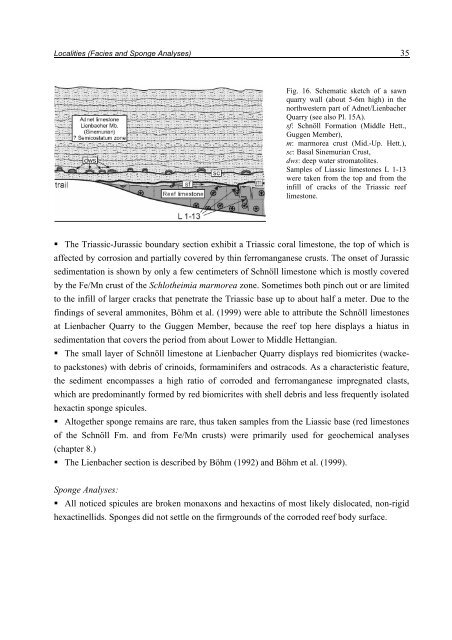Porifera-microbialites of the Lower Liassic (Northern Calcareous ...
Porifera-microbialites of the Lower Liassic (Northern Calcareous ...
Porifera-microbialites of the Lower Liassic (Northern Calcareous ...
Create successful ePaper yourself
Turn your PDF publications into a flip-book with our unique Google optimized e-Paper software.
Localities (Facies and Sponge Analyses) 35<br />
� The Triassic-Jurassic boundary section exhibit a Triassic coral limestone, <strong>the</strong> top <strong>of</strong> which is<br />
affected by corrosion and partially covered by thin ferromanganese crusts. The onset <strong>of</strong> Jurassic<br />
sedimentation is shown by only a few centimeters <strong>of</strong> Schnöll limestone which is mostly covered<br />
by <strong>the</strong> Fe/Mn crust <strong>of</strong> <strong>the</strong> Schlo<strong>the</strong>imia marmorea zone. Sometimes both pinch out or are limited<br />
to <strong>the</strong> infill <strong>of</strong> larger cracks that penetrate <strong>the</strong> Triassic base up to about half a meter. Due to <strong>the</strong><br />
findings <strong>of</strong> several ammonites, Böhm et al. (1999) were able to attribute <strong>the</strong> Schnöll limestones<br />
at Lienbacher Quarry to <strong>the</strong> Guggen Member, because <strong>the</strong> reef top here displays a hiatus in<br />
sedimentation that covers <strong>the</strong> period from about <strong>Lower</strong> to Middle Hettangian.<br />
� The small layer <strong>of</strong> Schnöll limestone at Lienbacher Quarry displays red biomicrites (wacke-<br />
to packstones) with debris <strong>of</strong> crinoids, formaminifers and ostracods. As a characteristic feature,<br />
<strong>the</strong> sediment encompasses a high ratio <strong>of</strong> corroded and ferromanganese impregnated clasts,<br />
which are predominantly formed by red biomicrites with shell debris and less frequently isolated<br />
hexactin sponge spicules.<br />
� Altoge<strong>the</strong>r sponge remains are rare, thus taken samples from <strong>the</strong> <strong>Liassic</strong> base (red limestones<br />
<strong>of</strong> <strong>the</strong> Schnöll Fm. and from Fe/Mn crusts) were primarily used for geochemical analyses<br />
(chapter 8.)<br />
� The Lienbacher section is described by Böhm (1992) and Böhm et al. (1999).<br />
Sponge Analyses:<br />
Fig. 16. Schematic sketch <strong>of</strong> a sawn<br />
quarry wall (about 5-6m high) in <strong>the</strong><br />
northwestern part <strong>of</strong> Adnet/Lienbacher<br />
Quarry (see also Pl. 15A).<br />
sf: Schnöll Formation (Middle Hett.,<br />
Guggen Member),<br />
m: marmorea crust (Mid.-Up. Hett.),<br />
sc: Basal Sinemurian Crust,<br />
dws: deep water stromatolites.<br />
Samples <strong>of</strong> <strong>Liassic</strong> limestones L 1-13<br />
were taken from <strong>the</strong> top and from <strong>the</strong><br />
infill <strong>of</strong> cracks <strong>of</strong> <strong>the</strong> Triassic reef<br />
limestone.<br />
� All noticed spicules are broken monaxons and hexactins <strong>of</strong> most likely dislocated, non-rigid<br />
hexactinellids. Sponges did not settle on <strong>the</strong> firmgrounds <strong>of</strong> <strong>the</strong> corroded reef body surface.

















